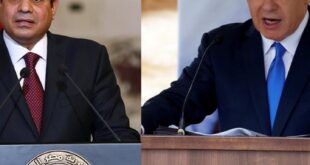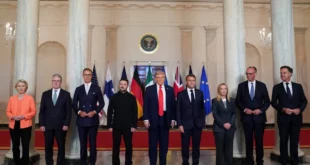Ukrainian President Volodymyr Zelensky stated on April 9 that Ukraine is interested in purchasing a large package of weapons from the United States, possibly within the framework of a future US-Ukraine mineral deal, as part of Ukrainian efforts to obtain security guarantees that would deter a future Russian invasion.[1] Zelensky stated on April 9 that Ukraine recently proposed to the United States that Ukraine purchase “30 to 50 billion” (likely USD) worth of air defense and weapons systems from the United States and that Ukraine is prepared to purchase these systems itself — either through direct payment to the United States or through the fund established by the potential US-Ukrainian minerals deal.[2] Zelensky stated that he recently told US President Donald Trump that Ukraine wants to buy at least 10 air defense systems to “help [Ukraine] after the end of the war” and that Ukraine will consider the provision of these air defense and weapons systems as a “security guarantee.”[3] ISW continues to assess that a strong Ukrainian military backed by Western security guarantees remains the most vital component of a stable post-war European security architecture, guaranteeing a sustainable peace in Ukraine and deterring future Russian aggression.[4]
Russia’s continued unsubstantiated accusations of Ukrainian violations of the energy strike ceasefire —despite the lack of any publicly available official ceasefire agreement — demonstrate how Russia will likely act in the event that Russia accepts the ground ceasefire to which Ukraine and the United States have already agreed. Russian Ministry of Foreign Affairs (MFA) Spokesperson Maria Zakharova claimed without evidence on April 9 that Ukrainian forces struck energy infrastructure in “Russian regions” 32 times between April 4 and 7.[5] The Russian Ministry of Defense (MoD) also claimed without evidence on April 10 that Ukraine conducted 11 strikes against energy facilities in occupied Luhansk, Donetsk, Zaporizhia, and Kherson oblasts; Krasnodar Krai; and Kursk, Bryansk, and Belgorod oblasts in the past day.[6] The Russian MoD claimed that Ukrainian forces struck energy facilities in the Russian near rear and rear in occupied Ukraine, including in Horlivka, Donetsk Oblast (roughly six kilometers from the frontline) and Holoprystanskyi Raion, Kherson Oblast (just south of the Dnipro River and inclusive of areas immediately on the east [left] bank of the Dnipro River). It is unclear if frontline energy infrastructure in the Russian near rear and rear are covered under the strikes ceasefire as the terms of the agreement have not been published. ISW continues to assess that Russian officials are using the lack of a clearly defined and public ceasefire agreement to cast Ukraine as a disingenuous participant in the peace negotiation process.[7] Russian officials’ continued insistence that Ukraine is violating the ceasefire underscores the importance of a signed and publicly available ceasefire agreement that includes monitoring and adjudication processes -elements that will be even more important in the potential future ground ceasefire to which the United States and Ukraine have already agreed.
Russia continues to use bilateral talks with the United States to delay negotiations about the war in Ukraine, suggesting that the Kremlin remains uninterested in serious peace negotiations to end the war. The US Department of State (DoS) reported that US and Russian delegations met in Istanbul on April 10 to discuss the finalization of “an understanding to ensure the stability of diplomatic banking for Russian and US bilateral missions.”[8] The US DoS stated that the US delegation reiterated concerns about the current Russian policy prohibiting the US Embassy in Moscow from employing local staff, which the United States sees as a barrier to the embassy’s stable and sustainable staffing. Kremlin Spokesperson Dmitry Peskov stated on April 10 that the Russian Ministry of Foreign Affairs (MFA) and the US DoS would only discuss bilateral relations and would not discuss Ukraine.[9] Russian Ambassador to the United States Alexander Darchiev stated on April 10 that the United States and Russia agreed to measures to facilitate the movement of diplomats and accelerate the granting of diplomatic visas.[10] Darchiev also stated that the Russian delegation prioritized discussions about the return of confiscated Russian diplomatic property in the United States.[11] Russia continues to use bilateral talks with the United States to discuss issues unrelated to the war in Ukraine, even as US President Donald Trump continues efforts to achieve the temporary ground ceasefire upon which both the United States and Ukraine have agreed.[12] The talks in Istanbul suggest that Russia is using diplomatic engagements with the United States to distract from the war and to obfuscate its own disinterest in productive peace negotiations.
Russia is reportedly using social media and financial incentives to recruit Chinese nationals to voluntarily join the Russian military. Ukrainian President Volodymyr Zelensky stated on April 9 that Ukrainian authorities have identified 155 Chinese citizens fighting with Russian forces in Ukraine but that there are likely many more.[13] Zelensky stated that Chinese nationals are fighting as part of the Russian 70th and 71st motorized rifle regiments (both of the 42nd Motorized Rifle Division, 58th Combined Arms Army [CAA], Southern Military District [SMD]) and the 255th Motorized Rifle Regiment (20th Motorized Rifle Division, 8th CAA, SMD). Elements of the 70th and 71st motorized rifle regiments are currently operating in western Zaporizhia Oblast, and elements of the 255th Motorized Rifle Regiment are reportedly operating in the Toretsk direction.[14] Zelensky stated that Russian forces are posting advertisements on TikTok and other Chinese social networks to recruit Chinese citizens and that the Chinese nationals traveled to Moscow, where they underwent medical examinations and one to two months of military training before deploying to Ukraine.[15] Ukraine’s Security Service (SBU) reported on April 9 that a Russian representative directly recruited one of the Chinese citizens, whom Ukrainian forces recently captured in Ukraine, in the People’s Republic of China (PRC) and that the Chinese citizen signed a contract with the Russian Ministry of Defense (MoD) upon arriving in Moscow in February 2025.[16] The SBU reported that another captured Chinese citizen went to Russia for tourism in December 2024 and signed an MoD contract after seeing an internet advertisement offering two million rubles (about $24,000) for joining the Russian military. Ukrainian outlet Kyiv Independent reported on April 9 that it viewed a Ukrainian intelligence document that stated that at least 163 Chinese citizens are serving in the Russian military as of early April 2025.[17] The Kyiv Independent reported that another document showed photos and passport details of 13 Chinese citizens fighting in the Russian military as of April 2. PRC Ministry of Foreign Affairs (MFA) Spokesperson Lin Jian stated on April 10 that the PRC MFA is unaware of the more than 155 Chinese citizens fighting with Russian forces in Ukraine.[18]
Russian forces reportedly recently executed a wounded Ukrainian prisoner of war (POW) in the Lyman direction. A source reportedly affiliated with Ukrainian military intelligence reported on April 8 that Russian sources published footage of two soldiers of the Russian 144th Motorized Rifle Division (20th Combined Arms Army [CAA], Moscow Military District [MMD]) executing a wounded Ukrainian soldier near Katerynivka (northeast of Lyman) recently on an unspecified date.[19] ISW has observed a sharp increase in credible reports and footage of Russian forces executing Ukrainian POWs throughout 2024 and 2025 and continues to assess that Russian military commanders are either complicit in or directly enabling subordinates to execute Ukrainian POWs in violation of international law.[20]
The Kremlin continues to use narratives it has historically used against Ukraine to set conditions to justify possible future aggression against Estonia. Russian MFA Spokesperson Maria Zakharova accused Estonia of conducting a “hunt” against Orthodoxy, and the MFA amplified the Russian Orthodox Church (ROC) Holy Synod’s accusations of Estonia’s persecution and oppression against Orthodox followers.[21] The Russian MFA and ROC claims come after the Estonian Parliament on April 9 passed amendments to the Churches and Congregations Act that would legally force the Estonian Orthodox Church to sever its affiliation with the ROC — Moscow Patriarchate (MP).[22] ISW has extensively reported on the Kremlin’s use of the ROC as a tool for its hybrid operations, particularly in occupied Ukraine and in former Soviet Union states, in order to repress religious freedom and promote pro-war and pro-Kremlin ideology.[23] The Kremlin has long been setting information conditions for hybrid operations against the Baltic states in the name of protecting Russian “compatriots abroad,” including against religious-based persecution, and may seek to combine and intensify these rhetorical efforts should Estonia codify these amendments into law.[24]
Key Takeaways:
Ukrainian President Volodymyr Zelensky stated on April 9 that Ukraine is interested in purchasing a large package of weapons from the United States, possibly within the framework of a future US-Ukraine mineral deal, as part of Ukrainian efforts to obtain security guarantees that would deter a future Russian invasion.
Russia’s continued unsubstantiated accusations of Ukrainian violations of the energy strike ceasefire - despite the lack of any publicly available official ceasefire agreement – demonstrate how Russia will likely act in the event that Russia accepts the ground ceasefire to which Ukraine and the United States have already agreed
Russia continues to use bilateral talks with the United States to delay negotiations about the war in Ukraine, suggesting that the Kremlin remains uninterested in serious peace negotiations to end the war.
Russia is reportedly using social media and financial incentives to recruit Chinese nationals to voluntarily join the Russian military.
Russian forces reportedly recently executed a wounded Ukrainian prisoner of war (POW) in the Lyman direction.
The Kremlin continues to use narratives it has historically used against Ukraine to set conditions to justify possible future aggression against Estonia.
Ukrainian forces recently advanced near Chasiv Yar, and Russian forces advanced near Toretsk and Pokrovsk.
A Russian insider source claimed that Russian authorities are preparing a dedicated position in Russian regional governments that will oversee veterans' affairs, and the federal government may include similar positions in the future.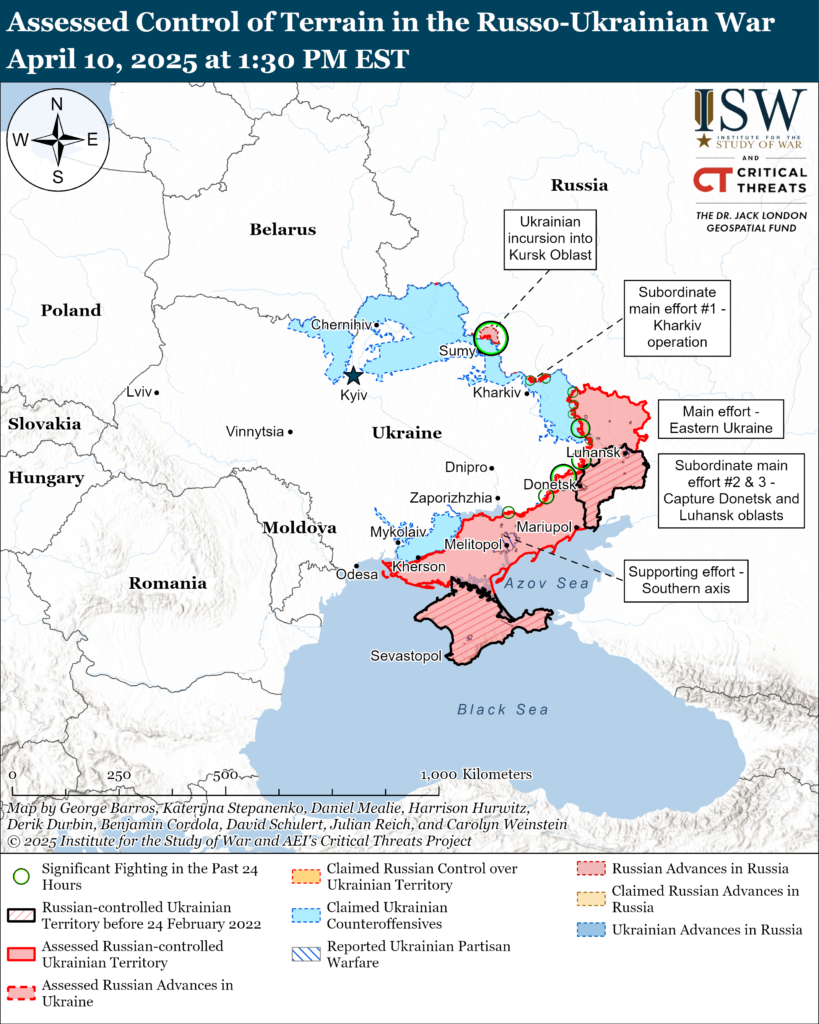
We do not report in detail on Russian war crimes because these activities are well-covered in Western media and do not directly affect the military operations we are assessing and forecasting. We will continue to evaluate and report on the effects of these criminal activities on the Ukrainian military and the Ukrainian population and specifically on combat in Ukrainian urban areas. We utterly condemn Russian violations of the laws of armed conflict and the Geneva Conventions and crimes against humanity even though we do not describe them in these reports.
Ukrainian Operations in the Russian Federation
Russian Main Effort – Eastern Ukraine (comprised of three subordinate main efforts)
Russian Subordinate Main Effort #1 – Push Ukrainian forces back from the international border with Belgorod Oblast and approach to within tube artillery range of Kharkiv City
Russian Subordinate Main Effort #2 – Capture the remainder of Luhansk Oblast and push westward into eastern Kharkiv Oblast and encircle northern Donetsk Oblast
Russian Subordinate Main Effort #3 – Capture the entirety of Donetsk Oblast
Russian Supporting Effort – Southern Axis
Russian Air, Missile, and Drone Campaign
Russian Mobilization and Force Generation Efforts
Russian Technological Adaptations
Activities in Russian-occupied areas
Significant Activity in BelarusAlleged Ceasefire Violations
Ukraine and Russia have not yet concluded a maritime ceasefire agreement due to ongoing Russian demands for Western sanctions relief. Negotiations regarding the conditions of the ceasefire on strikes against energy infrastructure are ongoing, and the resolution of these negotiations remains unclear.
See topline text for updates on Russian allegations of Ukrainian ceasefire violations.
Ukrainian Operations in the Russian Federation
Russian forces continued ground assaults in the Kursk-Sumy Oblast border area on April 10 but did not make confirmed advances.
Unconfirmed claims: The Russian MoD claimed on April 10 that Russian forces seized Zhuravka, Sumy Oblast (northeast of Sumy City), following Russian milblogger claims that Russian forces seized the settlement on March 2.[25] Russian milbloggers claimed on April 9 and 10 that elements of the Russian 83rd Airborne (VDV) Brigade seized Zhuravka and advanced further south of the settlement.[26] Russian milbloggers claimed that Russian forces also entered northern Loknya, Sumy Oblast (southeast of Zhuravka), and advanced in fields northeast of Loknya.[27]
Russian sources claimed that Russian forces continued ground attacks in Kursk Oblast near Oleshnya (southwest of Sudzha) and Gornal (south of Sudzha) and in Sumy Oblast near Zhuravka, Loknya, and Basivka (immediately northeast of Loknya).[28] Russian milbloggers claimed that Ukrainian forces counterattacked near Basivka and Veselivka (southwest of Zhuravka).[29]
The UK MoD reported on April 10 that roughly 5,000 of the 11,000 North Korean personnel fighting against Ukrainian forces — likely in Kursk Oblast — have sustained casualties, with roughly one-third of the total casualties being killed in action (KIA).[30]
Order of Battle: Elements of the Russian 1434th “Akhmat-Chechnya” Regiment are reportedly operating near Veselivka, and elements of the Russian 34th Motorized Rifle Brigade (49th Combined Arms Army [CAA], Southern Military District [SMD]) and drone operators of Rosgvardia Spetnaz are reportedly operating in Sumy Oblast.[31] Elements of the Russian “Rubikon” Center for Advanced Unmanned Technologies reportedly continue to operate in Kursk Oblast.[32]
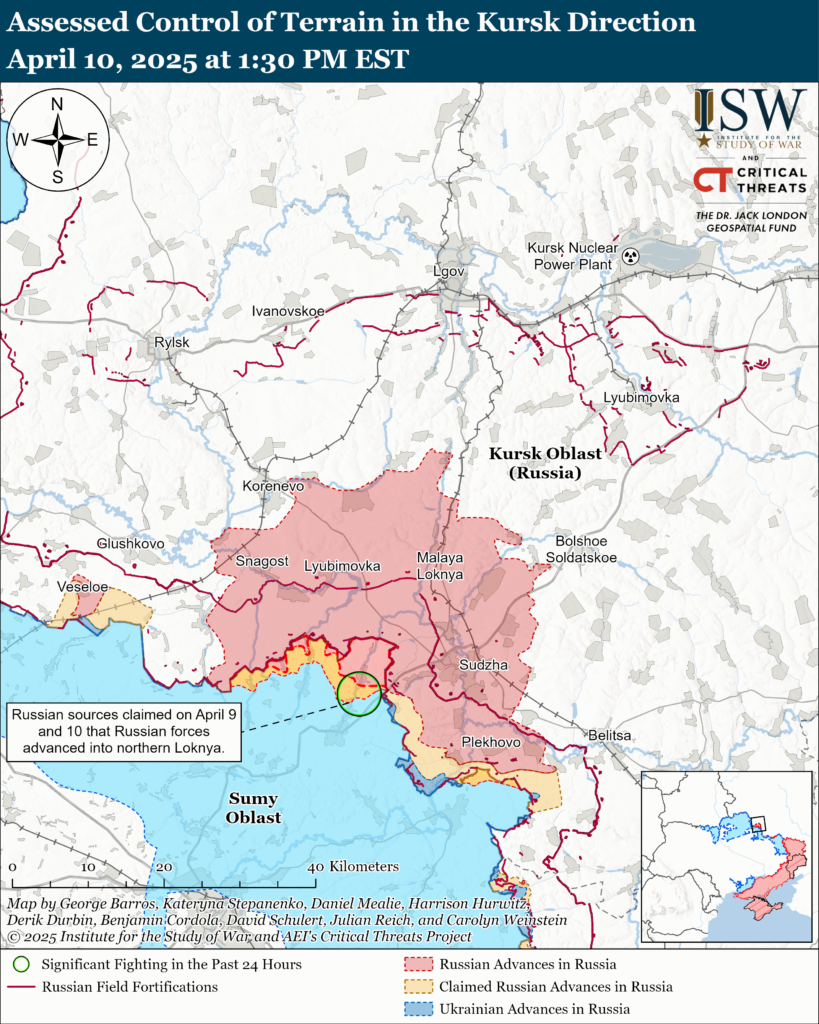
Ukrainian forces continued limited attacks in Belgorod Oblast on April 10.
Russian milbloggers claimed that Ukrainian forces continued ground attacks near Demidovka and Popovka (both northwest of Belgorod City along the international border).[33]
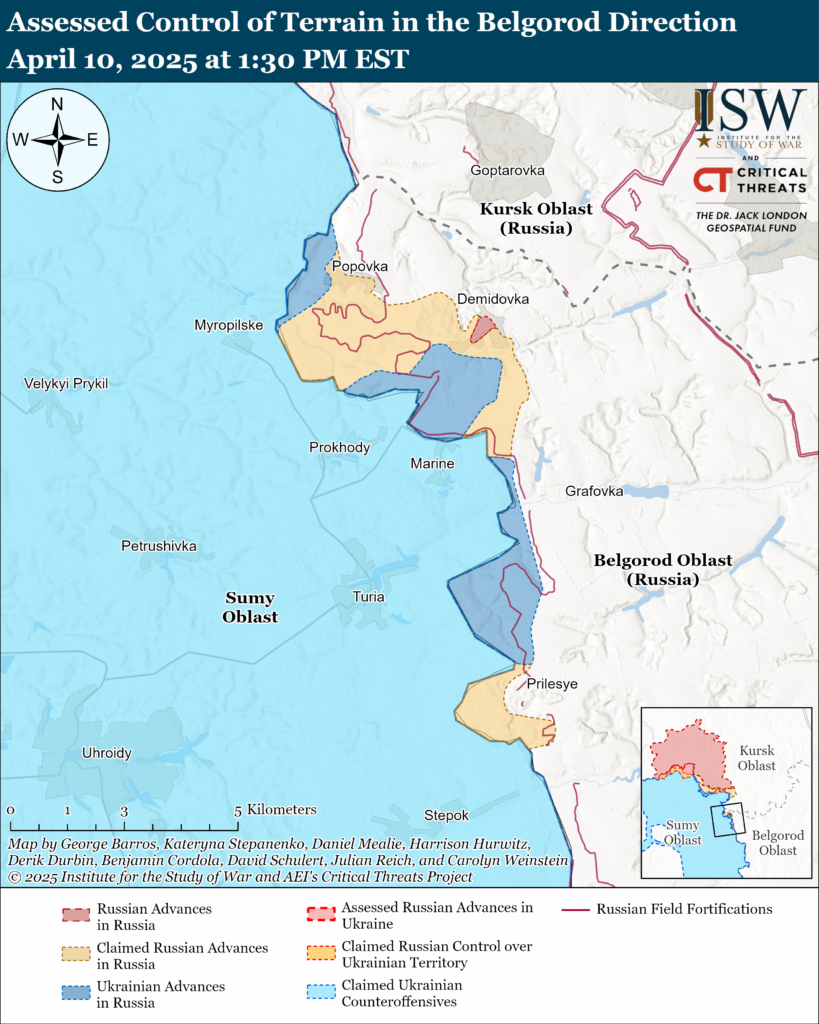
Russian Main Effort – Eastern Ukraine
Russian Subordinate Main Effort #1 – Kharkiv Oblast (Russian objective: Push Ukrainian forces back from the international border with Belgorod Oblast and approach to within tube artillery range of Kharkiv City)
Russian forces continued offensive operations in the Kharkiv direction on April 10 but did not advance.
Russian forces conducted offensive operations north of Kharkiv City near Hlyboke and northeast of Kharkiv City near Vovchansk on April 9 and 10.[34]
Order of Battle: Drone operators of the 41st Motorized Rifle Regiment (72nd Motorized Rifle Division, 44th Army Corps [AC], Leningrad Military District [LMD]) are reportedly operating in Kharkiv Oblast.[35]
Russian Subordinate Main Effort #2 – Luhansk Oblast (Russian objective: Capture the remainder of Luhansk Oblast and push westward into eastern Kharkiv Oblast and northern Donetsk Oblast)
Russian forces continued offensive operations in the Kupyansk direction on April 10 but did not advance.
Russian forces continued ground assaults northeast of Kupyansk near the international border near Kamyanka and Fyholivka and east of Kupyansk toward Pishchane on April 9 and 10.[36] A Russian milblogger claimed that Ukrainian forces counterattacked in an unspecified area in the Kupyansk direction.[37]
The spokesperson for a Ukrainian brigade operating in the Kupyansk direction reported on April 10 that Russian forces conducted several assaults, including some mechanized assaults, in the past week (roughly April 3 to 10) in order to probe for weak points in Ukrainian defenses.[38] The spokesperson of a Ukrainian border guard unit operating in the Kupyansk direction stated that Russian forces are actively assaulting with small infantry and armored groups and noted that Ukrainian forces can stop Russian attacks by conducting drone strikes into the Russian rear to destroy Russian logistics routes.[39]
Order of Battle: Drone operators of the Russian “Kontora” detachment (reportedly of the 375th Separate Anti-Tank Artillery Battalion, 47th Tank Division, 1st Guards Tank Army [GTA], Moscow Military District [MMD]) are reportedly operating in the Kupyansk direction.[40]
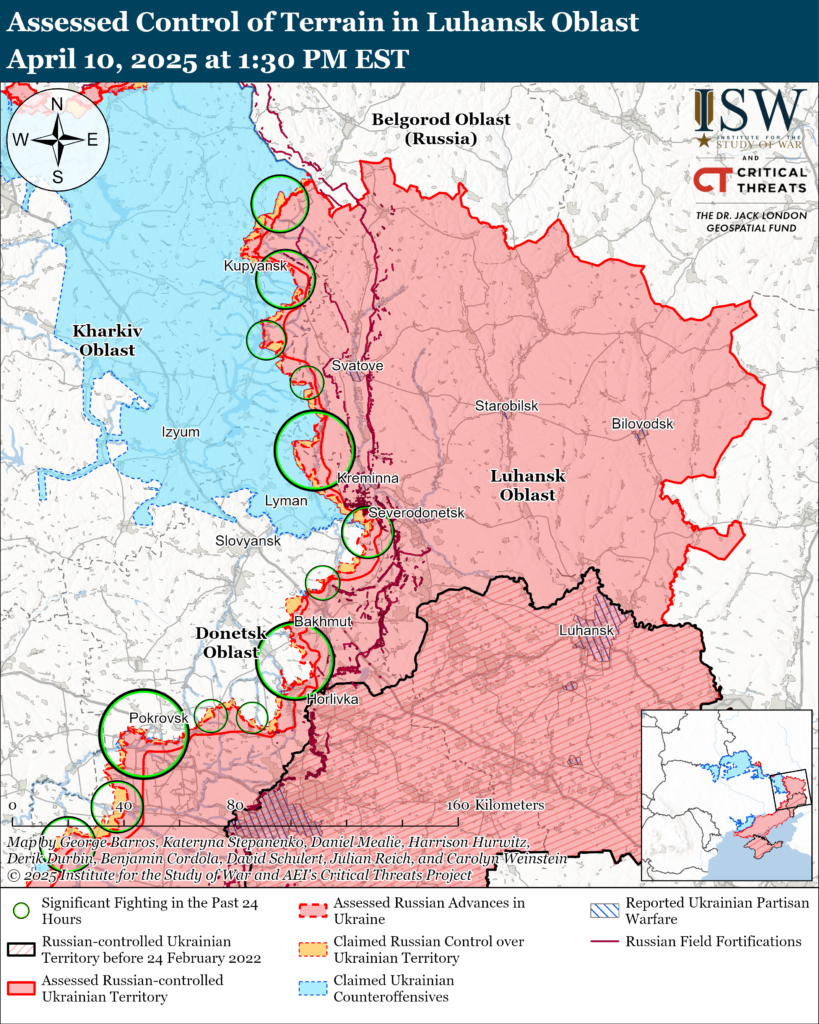
Russian forces continued ground attacks in the Borova direction on April 10 but did not make any confirmed advances.
Unconfirmed claims: A Russian milblogger claimed on April 10 that Russian forces seized Nadiya (east of Borova) and advanced south of the settlement.[41]
Russian forces continued assaults northeast of Borova near Zahryzove and Nova Kruhlyakivka, east of Borova near Serhiivka and Nadiya, and southeast of Borova near Hrekivka and toward Olhivka on April 9 and 10.[42]
Russian forces continued ground attacks in the Lyman direction on April 10 but did not advance.
Russian forces continued assaults northeast of Lyman near Nove, Katerynivka, Myrne, Yampolivka, and Kolodyazi and toward Novomykhailivka and Zelena Dolynaon on April 9 and 10.[43]
The spokesperson of a Ukrainian brigade operating in the Lyman direction reported on April 9 that Russian forces first attack in small groups consisting of one untrained — and sometimes unarmed — soldier and one well-trained soldier in order to expose and fire upon Ukrainian firing positions, after which more small Russian assault groups attack in the same direction after two to three hours.[44]
Russian Subordinate Main Effort #3 – Donetsk Oblast (Russian objective: Capture the entirety of Donetsk Oblast, the claimed territory of Russia’s proxies in Donbas)
Russian forces continued offensive operations in the Siversk direction on April 10 but did not advance.
Russian forces attacked north of Siversk toward Dronivka, northeast of Siversk near Hryhorivka and Bilohorivka, and east of Siversk near Verkhnokamyanske on April 9 and 10.[45]
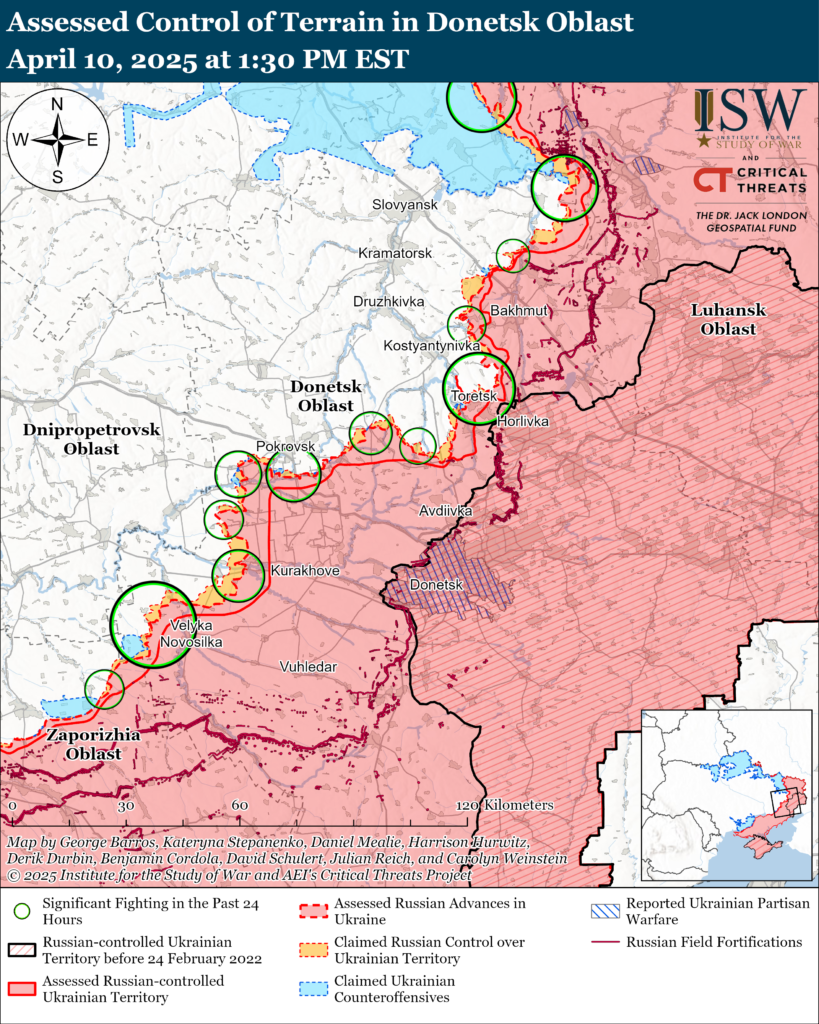
Ukrainian and Russian forces recently advanced in the Chasiv Yar direction.
Assessed Ukrainian advances: Geolocated footage published on April 10 indicates that Ukrainian forces recently marginally advanced along Tsentralna Street in western Chasiv Yar.[46]
Assessed Russian advances: Geolocated footage published on April 10 indicates that Russian forces recently advanced along Pryvokzalna Street in western Chasiv Yar.[47]
Russian forces conducted ground assaults near Chasiv Yar itself, southeast of Chasiv Yar near Kurdyumivka, and south of Chasiv Yar near Bila Hora and Stupochky on April 9 and 10.[48]
Order of Battle: Elements of the Russian “Sever-V” Brigade (Russian Volunteer Corps) and the 98th Airborne (VDV) Division, including its 217th VDV Regiment, are reportedly operating in and near Chasiv Yar.[49]
Russian forces recently advanced roughly four kilometers in the Toretsk direction but likely do not maintain enduring positions following the advance.
Assessed Russian advances: Geolocated footage published on April 7 indicates that Russian forces recently advanced roughly four kilometers along the T-0516 Toretsk-Kostyantynivka highway to Nelipivka (northeast of Toretsk and south of Kostyantynivka).[50] The footage shows Ukrainian forces striking two Russian vehicles along the road and Russian infantry dismounting to nearby areas. It is unclear if the dismounted infantry consolidated positions in nearby areas or if Russian forces were probing Ukrainian positions. Additional geolocated footage published on April 10 indicates that Russian forces recently advanced south of Krymske (northwest of Toretsk), but this change likely did not occur in the past 24 hours.[51]
Unconfirmed claims: Russian sources claimed that Russian forces advanced in central Toretsk, southwest of Ozaryanivka (northeast of Toretsk), near Druzhba (east of Toretsk), northeast of Krymske (northwest of Toretsk), and northeast of Shcherbynivka (west of Toretsk).[52]
Russian forces attacked near Toretsk itself, north of Toretsk near Dachne, east of Toretsk near Druzhba, southwest of Toretsk near Leonidivka and Oleksandropil, and west of Toretsk near Shcherbynivka on April 9 and 10.[53]
Order of Battle: Elements of the Russian 174th Separate Reconnaissance Battalion (150th Motorized Rifle Division, 8th Combined Arms Army [CAA], Southern Military District [SMD]), the 238th Artillery Brigade (8th CAA, SMD), and the 346th Spetsnaz Brigade (Russian General Staff’s Main Directorate [GRU]) are reportedly operating near Dyliivka (north of Toretsk).[54]
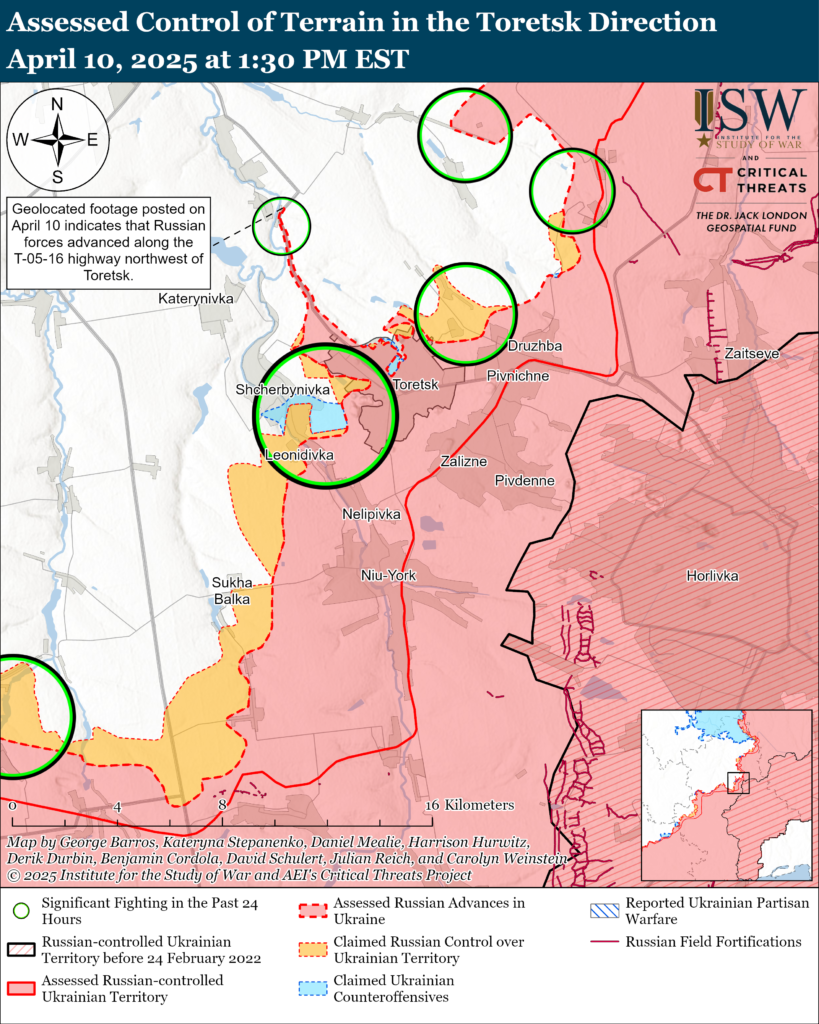
Russian forces recently advanced in the Pokrovsk direction.
Assessed Russian advances: Geolocated footage published on April 10 indicates that Russian forces recently advanced in southern and western Lysivka (southeast of Pokrovsk).[55]
Unconfirmed claims: A Russian milblogger claimed that Russian forces advanced in central Kalynove (east of Pokrovsk), while another claimed that Russian forces seized the settlement.[56] Russian sources claimed that Russian forces seized Nadiivka, entered Kotlyarivka (both southwest of Pokrovsk), and advanced in Troitske (south of Kotlyarivka) and northwest of Vodyane Druhe (northeast of Pokrovsk).[57]
Russian forces conducted offensive operations northeast of Pokrovsk near Oleksandropil and Vodyane Druhe; east of Pokrovsk near Yelyzavetivka, Zelene Pole, and Kalynove; southeast of Pokrovsk near Lysivka; and southwest of Pokrovsk near Kotlyarikva, Zvirove, Udachne, Preobrazhenka, Bohdanivka, Troitske, Novooleksandrivka, and Kotlyne and toward Serhiivka on April 9 and 10.[58] Ukraine’s Khortytsia Group of Forces reported on April 10 that Russian forces unsuccessfully conducted a reduced company-sized mechanized assault consisting of eight armored vehicles toward Yelyzavetivka and that Ukrainian forces destroyed one tank and six armored vehicles.[59]
Ukraine’s Khortytsia Group of Forces Spokesperson Colonel Viktor Trehubov stated that Russian forces continue attempts to bypass Pokrovsk from the west and to reach the T-0504 Pokrovsk-Kostyantynivka highway.[60] Trehubov noted that Russian forces will have to attack and seize Pokrovsk in order to achieve the Kremlin’s political goal of seizing all of Donetsk Oblast. Trehubov stated that Russian forces are using nets to protect ground lines of communication (GLOCs) from Ukrainian drones. The spokesperson of a Ukrainian brigade operating in the Pokrovsk direction stated that Russian forces recently conducted a reinforced platoon-sized mechanized assault consisting of three infantry fighting vehicles (IFVs) and one tank in the first wave and two additional IFVs in the second wave in an unspecified area in the Pokrovsk direction.[61] The spokesperson stated that Russian forces tried to conceal the attack using snowy weather and a smoke screen but that windy conditions mitigated the smoke screen and allowed Ukrainian forces to identify and repel the attack. The spokesperson stated that Russian forces conduct mechanized assaults roughly every two to three days and that Russian forces conduct infantry attacks in groups of two to three personnel on the other days. The spokesperson of a Ukrainian brigade operating in the Novopalivka direction (southwest of Pokrovsk) stated that Russian forces only launch attacks after they have destroyed frontline settlements with artillery.[62] The spokesperson stated that Russian forces are withdrawing units that have lost their combat capabilities from the frontline and are constantly replenishing troops with infantry. The spokesperson stated that Ukrainian drones are destroying 70 to 80 percent of the assault groups. A Russian milblogger claimed that half of Kotlyarivka is a contested “gray zone.”[63]
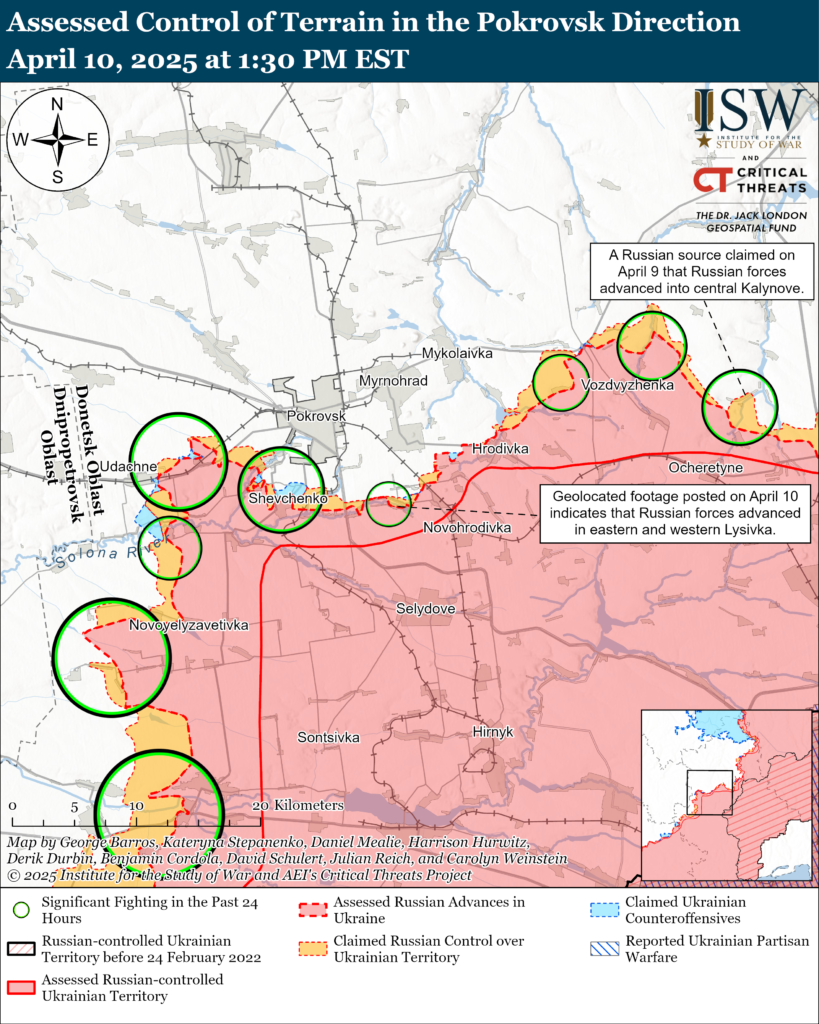
Russian forces continued offensive operations in the Kurakhove direction on April 10 but did not make confirmed advances.
Unconfirmed claims: Russian milbloggers claimed that Russian forces advanced south of Bahatyr (west of Kurakhove) and north and northwest of Rozlyv (southwest of Kurakhove).[64]
Russian forces conducted offensive operations west of Kurakhove near Andriivka, Kostyantynopil, and Bahatyr and southwest of Kurakhove near Rozlyv on April 9 and 10.[65]
Order of Battle: Drone operators of the Russian 14th Spetsnaz Brigade (Russian General Staff’s Main Directorate [GRU]) are reportedly operating near Bahatyr.[66] Elements of the Russian 200th Artillery Brigade (29th CAA, Eastern Military District [EMD]) are reportedly striking Ukrainian targets in Bahatyr.[67]
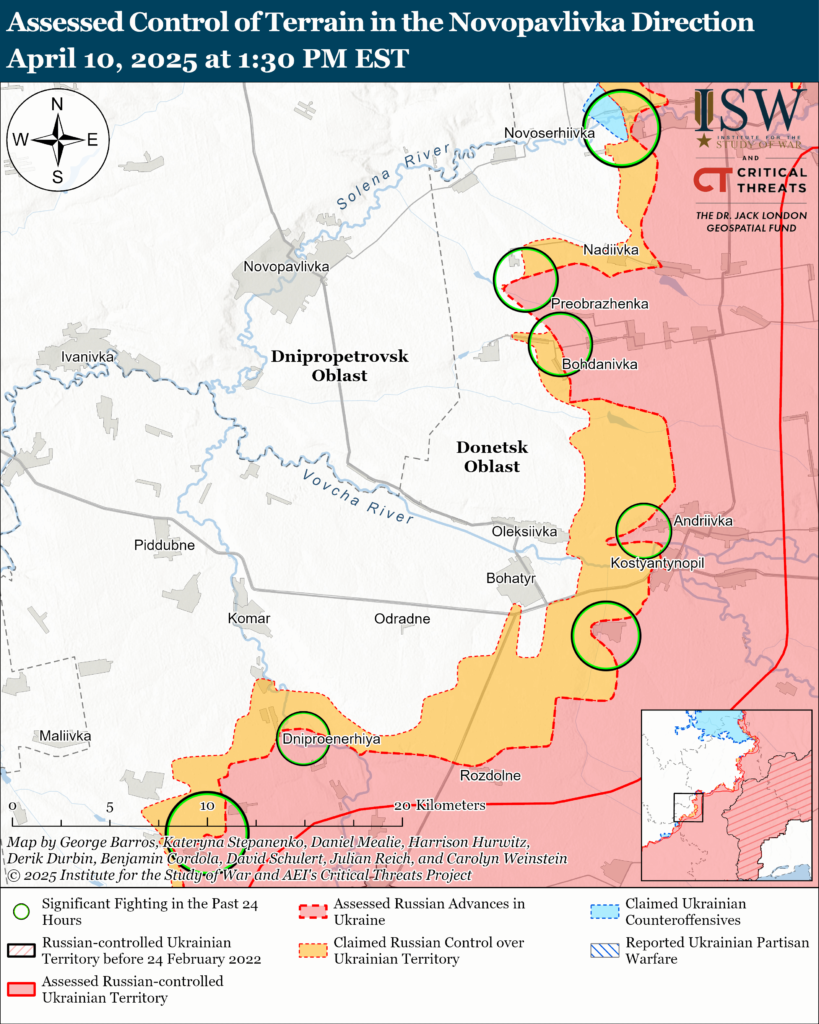
Russian forces continued offensive operations in the Velyka Novosilka direction on April 10 but did not make confirmed advances.
Unconfirmed claims: A Russian milblogger claimed on April 10 that Russian forces advanced south and southeast of Fedorivka (northwest of Velyka Novosilka) and northeast of Shevchenko (northwest of Velyka Novosilka).[68]
Russian forces continued ground attacks northwest of Velyka Novosilka near Pryvilne and toward Shevchenko on April 9 and 10.[69]
Russian Supporting Effort – Southern Axis (Russian objective: Maintain frontline positions and secure rear areas against Ukrainian strikes)
Russian forces continued offensive operations in western Zaporizhia Oblast on April 10 but did not make confirmed advances.
Unconfirmed claims: Russian milbloggers claimed that Russian forces advanced in Mali Shcherbaky (northwest of Robotyne).[70]
Russian forces conducted ground attacks northwest of Robotyne near Stepove, Lobkove, Mali Shcherbaky, and Shcherbaky on April 9 and 10.[71] A Russian milblogger claimed on April 10 that Ukrainian forces are counterattacking along the Lobkove-Stepove-Shcherbaky line.[72]
Order of Battle: Drone operators of the “Shaman” detachment of the Russian 1455th Motorized Rifle Regiment (reportedly of the 42nd Motorized Rifle Division, 58th Combined Arms Army [CAA], Southern Military District [SMD]) and artillery elements of the 42nd Motorized Rifle Division are reportedly operating in the Orikhiv direction.[73] Elements of the 291st Motorized Rifle Regiment (42nd Motorized Rifle Division, 58th CAA, SMD) are reportedly operating near Robotyne.[74] Elements of the 503rd Motorized Rifle Regiment (19th Motorized Rifle Division, 58th CAA, SMD) are reportedly operating in Shcherbaky, and elements of the 108th Airborne (VDV) Regiment (7th VDV Division) are reportedly operating in Mali Shcherbaky.[75]
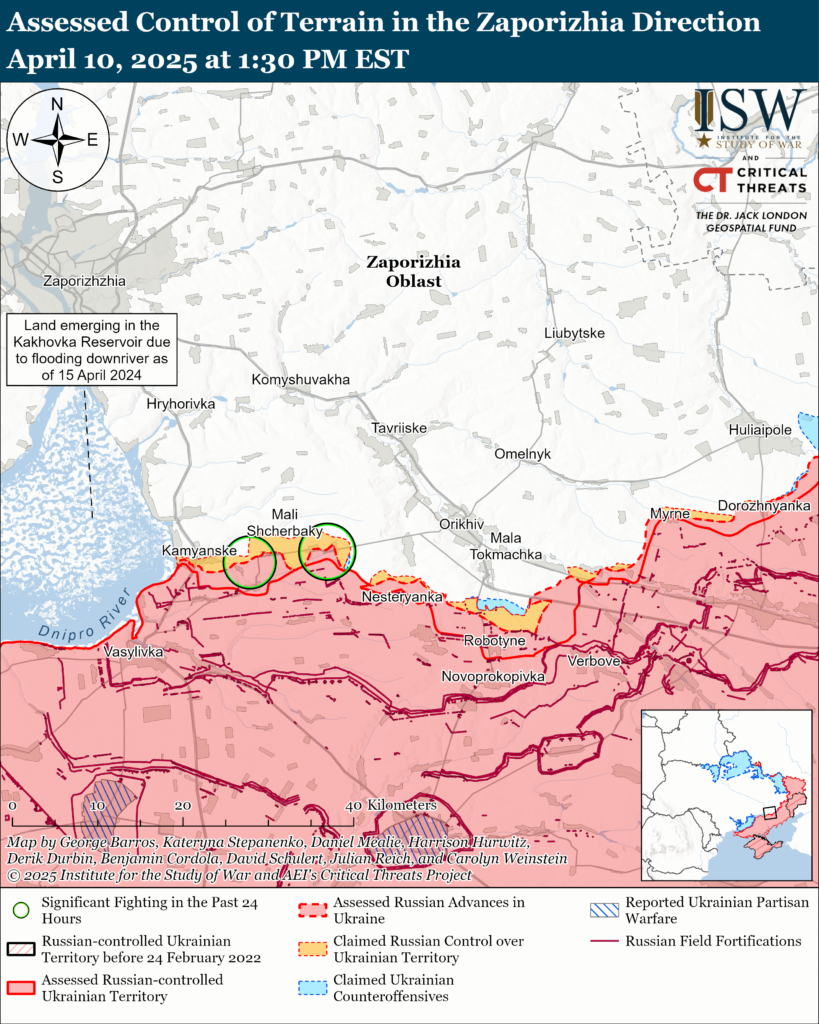
Russian forces conducted limited offensive operations in the Dnipro (Kherson) direction on April 10 but did not advance.[76]
Ukrainian Navy Spokesperson Captain Third Rank Dmytro Pletenchuk reported on April 10 that Russian naval vessels continue to avoid operating in the Sea of Azov.[77] Pletenchuk stated that Russian forces are moving the remnants of the Russian fleet in occupied Crimea every day due to the threat of Ukrainian drone strikes. Pletenchuk stated that alternative Russian naval bases, such as those in Sochi or Tuapse, Krasnodar Krai do not have as much protection as the Russian base in Novorossisyk, Krasnodar Krai, and that Russian forces are struggling to use the port in Ochamchire in Russian-controlled Abkhazia, Georgia. Pletenchuk noted that Russian forces continue to launch Shahed drones from occupied Crimea.
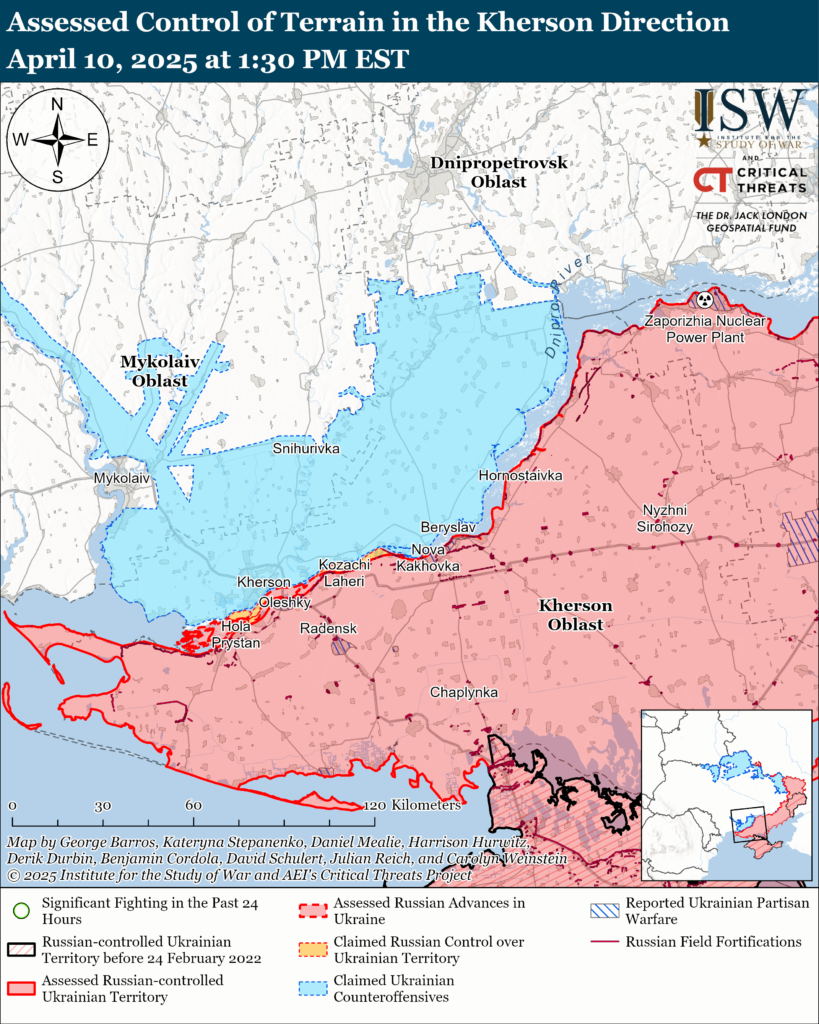
Russian Air, Missile, and Drone Campaign (Russian Objective: Target Ukrainian military and civilian infrastructure in the rear and on the frontline)
Russian forces conducted a large series of drone strikes against Ukraine on the night of April 9 to 10 and a ballistic missile strike against Dnipro City on the afternoon of April 10. The Ukrainian Air Force reported that Russian forces launched 145 Shahed and decoy drones from the directions of Kursk and Oryol cities; Millerovo, Rostov Oblast; Primorsko-Akhtarsk, Krasnodar Krai; and occupied Cape Chauda, Crimea overnight on April 9 to 10.[78] The Ukrainian Air Force reported that Ukrainian forces shot down 85 drones over northern, southern, eastern, and central Ukraine and that 49 decoy drones were “lost,” likely due to Ukrainian electronic warfare (EW) interference. Ukrainian officials reported that Russian drones damaged infrastructure in Donetsk, Kharkiv, Kyiv, Khmelnytskyi, Poltava, and Mykolai oblasts.[79] Dnipropetrovsk Oblast Head Serhii Lysak later reported on April 10 that Russian forces struck a civilian facility in Dnipro City with a ballistic missile, killing one and injuring three civilians.[80]
Ukrainian Air Force Spokesperson Colonel Yuriy emphasized the importance of Patriot air defense systems in bolstering Ukraine’s ability to defend against Russian ballistic missile strikes. Ihnat stated on April 10 that Ukrainian forces have shot down 100 Iskander-K cruise missiles; 97 Iskander-M and KN-23 ballistic missiles; 40 Kinzhal aeroballistic missiles; and 2,400 Kh-101 and Kalibr cruise missiles since February 24, 2022, and noted that US-provided Patriot systems are the only air defense system that Ukraine possesses capable of shooting down Russian ballistic missiles.[81] Ihnat also reported on April 10 that Russian forces directed large numbers of Shaheds toward a single oblast in order to overload Ukrainian air defenses.[82] Ihnat stated that mobile fire groups remain critical to Ukraine’s ability to defend against Russian drone strikes. ISW recently assessed that Russia is increasingly using strike packages comprised mainly of drones as they stockpile missiles, suggesting that a combined air defense umbrella using all air defense assets available to Ukraine will continue to be of paramount importance.[83]
Russian Mobilization and Force Generation Efforts (Russian objective: Expand combat power without conducting general mobilization)
A Russian insider source claimed that Russian authorities are preparing a dedicated position in Russian regional governments that will oversee veterans’ affairs, and the federal government may include similar positions in the future.[84] The insider source claimed that Sverdlovsk Oblast has already approved the creation of the “Regional Minister for Veterans of the Special Military Operation” post.[85] The insider source claimed that the Sverdlovsk Oblast ministerial position is intended to be a test run before establishing similar roles in other federal subjects and eventually a federal position that would cover “dozens” of Russian federal subjects. The insider source claimed that this new regional position is part of a broader effort to build a new power vertical connecting the Russian federal government to Russian veterans more directly and to promote Russian veterans as “bearers of a special status and legitimacy.” The Kremlin has been attempting to militarize the Russian government and society by promoting participants of its “Time of Heroes” program and regional offshoot programs that place Russian veterans of the war in Ukraine in federal, regional, and local government positions.[86] The Time of Heroes program announced on April 9 that its participant Vitaly Drozdov received an appointment as Russian state telecommunications operator Rostelecom’s Chief Architect for Special Communications.[87]
Radio Free Europe/Radio Liberty’s Systema project provided details on relatively elite Russian Storm-Z units comprised of penal recruits that have fought in Ukraine. Systema reported on April 9 that the Russian MoD formed three experimental elite assault units from former penal recruits: the “Storm Gladiator” detachment (58th Combined Arms Army [CAA], Southern Military District [SMD]), the “Akula” detachment, and the “Chernye Bushlaty” detachment.[88] Systema reported that that the “Storm Gladiator” detachment is primarily comprised of prisoners who had prior experience in the Russian military and security organizations, including fighters from the Chechen wars, and that the detachment consistently sustains high losses on the battlefield in Ukraine. Systema reported that the Russian military formed the “Akula” detachment in Spring 2023 and that the detachment included prisoners from maximum security penal colonies. Former Vladimir Oblast Deputy Governor Dmitry Khovstov, whom Russian authorities convicted of accepting a large bribe, was reportedly one of the detachment commanders. Systema reported that the “Chernye Bushlaty” detachment fought alongside Chechen Akhmat Spetsnaz in the industrial zone of Bilohorivka, Luhansk Oblast, in 2023 and sustained heavy losses.
Russian Technological Adaptations (Russian objective: Introduce technological innovations to optimize systems for use in Ukraine)
A Russian milblogger who sends assistance to Russian forces on the frontline announced on April 10 that they are sending their first batch of 3D printed anti-drone bullets for Kalashnikov assault rifles.[89]
Activities in Russian-occupied areas (Russian objective: Consolidate administrative control of annexed areas; forcibly integrate Ukrainian citizens into Russian sociocultural, economic, military, and governance systems)
ISW is suspending occupation coverage in its daily Russian Offensive Campaign Assessments. ISW is introducing a new product line tracking activities in Russian-occupied areas of Ukraine. The occupation updates will examine Russian efforts to consolidate administrative control of annexed areas and forcibly integrate Ukrainian citizens into Russian sociocultural, economic, military, and governance systems. Click here to read the Russian Occupation Update.
Significant activity in Belarus (Russian efforts to increase its military presence in Belarus and further integrate Belarus into Russian-favorable frameworks)
Nothing significant to report.
Note: ISW does not receive any classified material from any source, uses only publicly available information, and draws extensively on Russian, Ukrainian, and Western reporting and social media as well as commercially available satellite imagery and other geospatial data as the basis for these reports. References to all sources used are provided in the endnotes of each update.
 Eurasia Press & News
Eurasia Press & News
